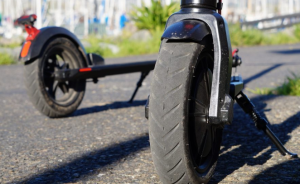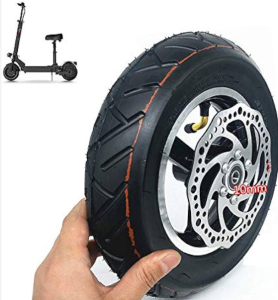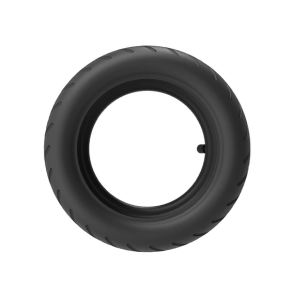Yes, many electric scooters have pneumatic tyres, known for better shock absorption and a smoother ride compared to solid tyres.
Understanding Pneumatic Tyres
Pneumatic tyres, often recognized for their air-filled construction, stand out due to their ability to improve both performance and comfort in various types of vehicles, including electric scooters. These tyres, made from a flexible rubber compound, encase a pressurized air chamber that provides cushioning.
Definition and Characteristics
Pneumatic tyres are characterized by their air-filled design, which allows them to absorb shocks from uneven road surfaces effectively. Unlike solid tyres, which are entirely made of rubber or polyurethane without any air chamber, pneumatic tyres can significantly reduce the impact on the rider and the vehicle. This feature is crucial for electric scooters, where ride comfort can be directly influenced by the type of tyres used.
Benefits of Pneumatic Tyres for Electric Scooters
Improved Comfort and Handling: The cushioning effect of air allows pneumatic tyres to offer superior ride comfort compared to solid tyres. They can absorb bumps and potholes, making for a smoother ride. Handling is also enhanced, as these tyres provide better traction and adaptability to various road conditions.
Increased Efficiency: Pneumatic tyres can also contribute to a more efficient ride. By absorbing road vibrations, they reduce energy loss, allowing the electric scooter to maintain higher speeds with less power consumption. Studies suggest that electric scooters equipped with pneumatic tyres require less energy to cover the same distance as those with solid tyres, potentially improving battery life and range by up to 10%.
Safety Benefits: The improved grip and traction provided by pneumatic tyres enhance the safety of electric scooters, especially on wet or slippery surfaces. The flexibility of the tyre allows for a larger contact area with the ground, which can significantly reduce braking distances.
Drawbacks of Pneumatic Tyres
Maintenance Requirements: One of the main disadvantages of pneumatic tyres is their susceptibility to punctures and leaks. Regular checks and maintenance are necessary to ensure they are properly inflated and free from damage, which can be a hassle for some users.
Cost Implications: While the initial purchase price of pneumatic tyres might not be significantly higher than that of solid tyres, the potential need for repairs or replacements due to punctures can add to the overall cost of ownership.
Weight Considerations: Pneumatic tyres are generally heavier than their solid counterparts. This additional weight can slightly reduce the electric scooter’s maximum speed and range, although the impact is often minimal compared to the benefits in comfort and efficiency.
Comparison of Tyre Types
Electric scooters typically come with either pneumatic (air-filled) or solid (airless) tyres, each with its unique set of characteristics affecting ride quality, durability, and maintenance requirements.
Pneumatic vs. Solid Tyres
| Feature | Pneumatic Tyres | Solid Tyres |
|---|---|---|
| Comfort | High – Absorb shocks and bumps better | Low – Harder, feel more vibrations |
| Traction | High – Better grip due to flexibility | Moderate – Less flexible, less grip |
| Efficiency | Moderate to High – Lower rolling resistance increases range | Lower – Higher rolling resistance reduces range |
| Maintenance | Higher – Prone to punctures and require regular air pressure checks | Low – No puncture risks, no air pressure maintenance |
| Durability | Varies – Can wear out faster if not properly maintained | High – Typically last longer due to solid construction |
| Initial Cost | Varies – Generally comparable to solid tyres | Varies – Generally comparable to pneumatic tyres |
| Replacement Cost | Moderate – Frequent replacements may be needed | Low to Moderate – Less frequent replacements required |
Impact on Ride Quality
Pneumatic tyres significantly enhance ride comfort by absorbing shocks and vibrations, making them ideal for uneven terrains. Their flexibility allows for a larger contact area with the ground, providing better traction and handling. This results in a smoother and more enjoyable ride, especially over longer distances.
Solid tyres, on the other hand, transfer more vibrations and shocks directly to the rider due to their lack of air cushioning. While this can lead to a bumpier ride, they eliminate the concern of tyre punctures, making them a popular choice for urban commuters who prioritize reliability over comfort.
Durability and Maintenance Considerations
Pneumatic tyres, while offering superior comfort and performance, require more maintenance. They are susceptible to punctures from sharp objects, which can lead to unexpected downtime and repair costs. Regular checks and adjustments of air pressure are also necessary to ensure optimal performance and longevity.
Solid tyres eliminate the worry of punctures and air pressure maintenance, providing a hassle-free option. Their inflexibility can lead to faster wear in certain conditions, and once worn, they must be completely replaced, which can be more complex than fixing a pneumatic tyre.
How to Determine if Your Electric Scooter Has Pneumatic Tyres
Determining the type of tyres on your electric scooter is crucial for maintenance, performance assessment, and when considering upgrades or replacements. Here’s how you can identify if your scooter is equipped with pneumatic tyres and where to find detailed specifications.
Identifying Tyre Types
Visual Inspection: Start with a simple visual check. Pneumatic tyres typically have a valve stem protruding from the wheel rim, similar to those on a bicycle or car tyre. This valve is for inflating the tyre with air. In contrast, solid tyres lack this feature since they do not require air.
Press the Tyre: Gently press against the tyre’s surface. Pneumatic tyres, being air-filled, will offer some degree of give or compression under pressure. Solid tyres, made from a hard rubber or polyurethane material, will feel much firmer and will not compress easily.
Check for Tread Wear: Examine the tread wear patterns. Pneumatic tyres often display more pronounced and uneven wear patterns due to their flexibility and air cushioning. Solid tyres may wear down more uniformly because they distribute weight and stress differently.
Weight Differences: Pneumatic tyres are generally lighter than solid ones because they consist mostly of air contained within a rubber casing. If you have a way to compare, you might find your scooter lighter with pneumatic tyres than it would be if it had solid tyres.
Listen for Sound: Drop the scooter from a low height and listen to the sound it makes upon landing. A scooter with pneumatic tyres will produce a softer, more muted sound due to air absorption, whereas solid tyres will generate a sharper, more solid noise.
Manufacturer Specifications and Manuals
Consult the User Manual: The most reliable method to determine your tyre type is to consult the scooter’s user manual. Manufacturers usually specify the tyre type, along with other crucial specifications like size, recommended air pressure for pneumatic tyres, and maintenance tips.
Manufacturer’s Website: If you no longer have access to the physical manual, most manufacturers provide digital copies on their websites. These resources often contain detailed product specifications, including tyre types, and may offer additional maintenance and care advice specific to your scooter model.
Customer Support: For direct information, contact the manufacturer’s customer support. Provide them with your scooter’s model number, and they can confirm the tyre type and provide guidance on care, maintenance, or replacement.
Look for Product Reviews: Sometimes, product reviews and forums can offer insights into the specifics of your scooter, including tyre type. Other users might share their experiences and maintenance tips related to pneumatic tyres.
By combining these methods, you can confidently identify whether your electric scooter has pneumatic tyres and understand the implications for maintenance and performance. Proper identification helps in making informed decisions regarding tyre care, potential upgrades, and replacements, ensuring the longevity and optimal functioning of your scooter.

Care and Maintenance of Pneumatic Tyres
Proper care and maintenance of pneumatic tyres are crucial for ensuring the longevity and performance of your electric scooter. By adhering to a few best practices, you can significantly extend the life of your tyres and enjoy a smoother ride.
Regular Inspection and Air Pressure Checks
Consistent Inspection: Regularly inspect your tyres for any signs of wear, damage, or foreign objects lodged in the tread. Early detection of issues can prevent more significant problems down the line.
Air Pressure Checks: Checking the air pressure in your pneumatic tyres is essential. Manufacturers recommend specific air pressures (measured in PSI – pounds per square inch) for optimal performance and safety. Under-inflated tyres can lead to increased wear and tear, decreased efficiency, and a higher risk of punctures. Over-inflation can make the ride harsher and increase the chances of tyre rupture. Use a reliable tyre pressure gauge to ensure your tyres are at the correct pressure, and adjust accordingly.
Frequency of Checks: Perform air pressure checks at least once a month and before long rides. Temperature changes can affect air pressure, with tyres losing approximately 1 PSI per month naturally. In warmer conditions, the air expands, possibly increasing pressure, whereas cooler temperatures can reduce it.
Repairing Punctures in Pneumatic Tyres
Puncture Repair Kits: It’s advisable to have a puncture repair kit or a tyre sealant designed for pneumatic tyres. For minor punctures, these can be effective solutions that allow you to repair the tyre without removing it from the scooter.
Professional Repairs: For larger punctures or if you’re unsure how to proceed, seek professional help. Specialists can assess the damage accurately and recommend whether the tyre can be repaired or needs replacing.
Replacement vs. Repair: If the tyre’s structural integrity is compromised, or it has multiple punctures, replacing the tyre is often safer and more cost-effective in the long run.
Best Practices for Tyre Longevity
Riding Habits: Your riding habits significantly impact tyre wear. Avoiding sharp objects, rough terrain, and sudden accelerations or stops can reduce wear and tear.
Storage Conditions: Store your electric scooter in a cool, dry place to prevent the rubber in the tyres from deteriorating prematurely. Prolonged exposure to direct sunlight or extreme temperatures can adversely affect the material quality and lifespan of pneumatic tyres.
Regular Cleaning: Keep the tyres clean from dirt, mud, and debris. This not only helps in maintaining good traction but also allows you to inspect the tyres more thoroughly during your regular checks.
Tyre Rotation: If possible, rotate your tyres periodically. This practice can ensure even wear, extending the lifespan of your tyres.
By following these care and maintenance tips, you can maximize the performance and longevity of your electric scooter’s pneumatic tyres. Regular maintenance not only saves money on replacements but also ensures a safer and more enjoyable riding experience.

